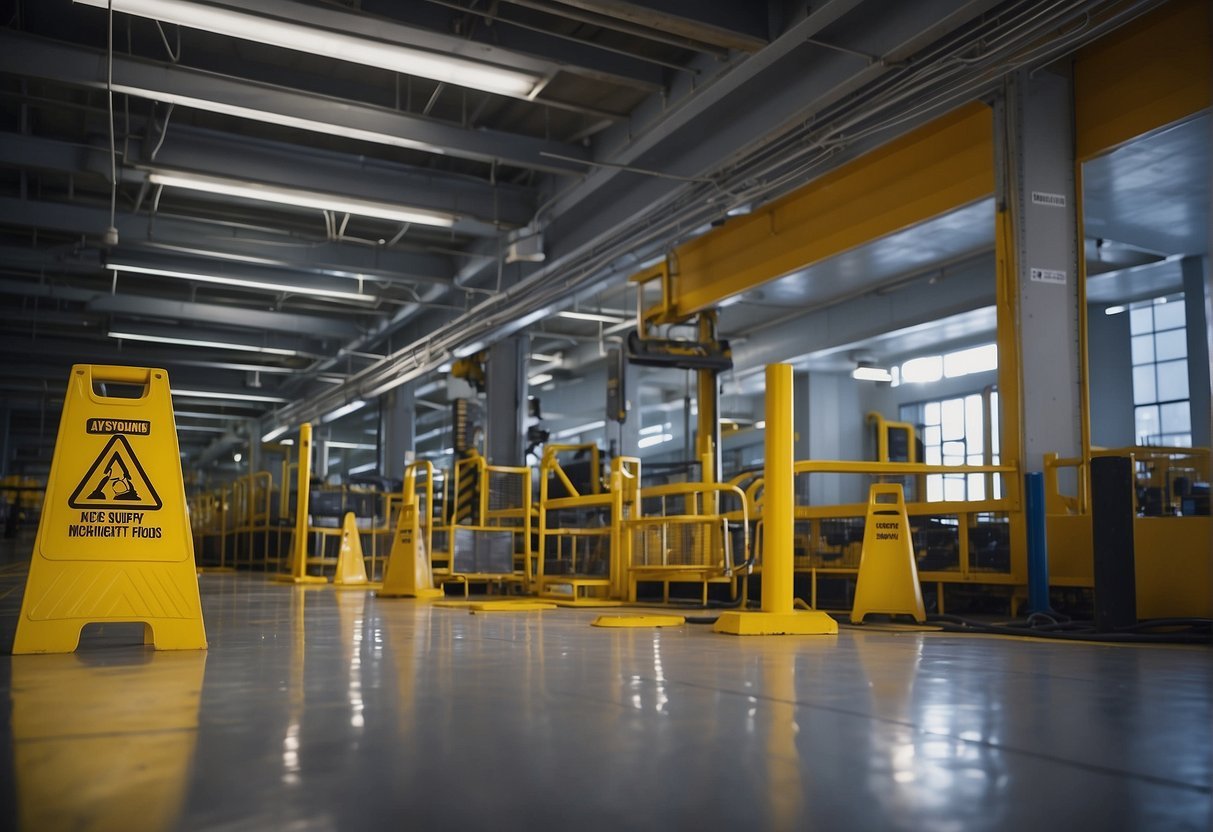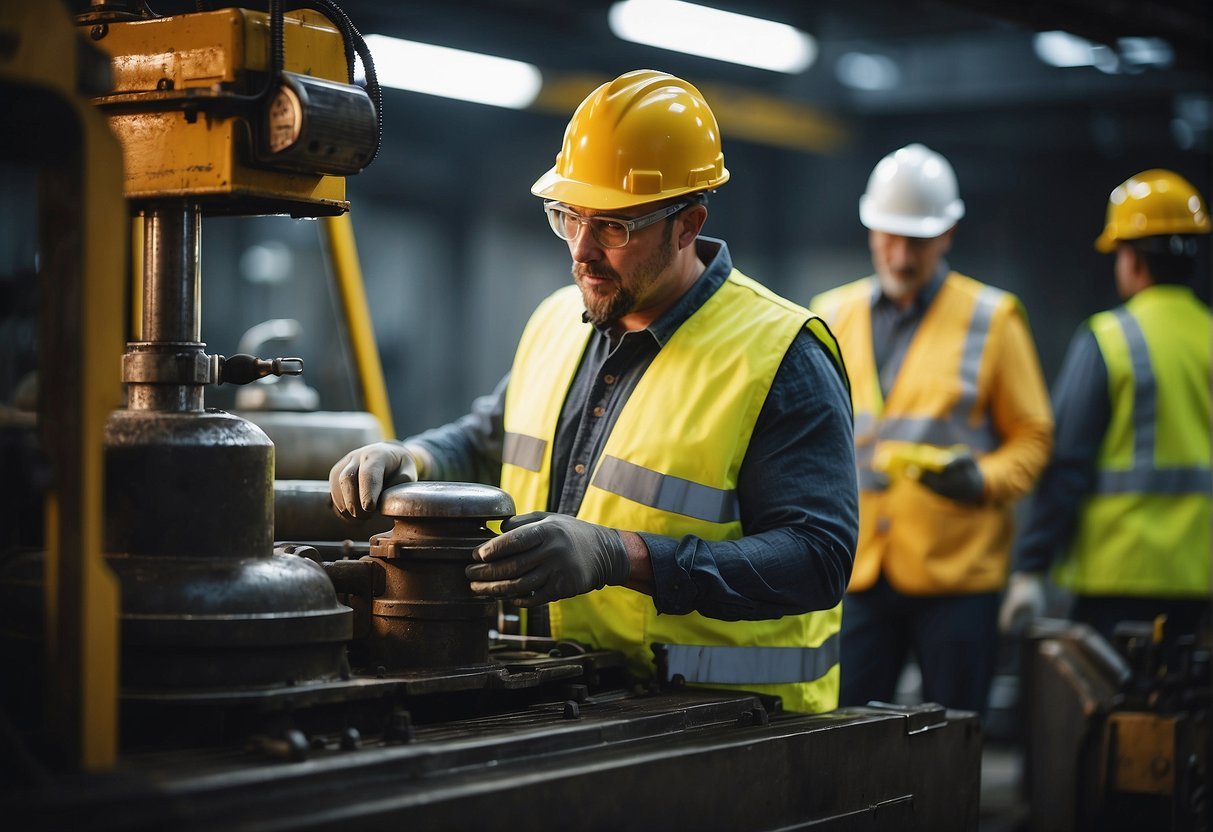نصائح للسلامة في مكان العمل – الممارسات الأساسية لبيئة عمل آمنة
“Every Employee Plays a Role in Ensuring Workplace Safety”

Safety in the workplace is an indispensable aspect of a healthy and productive work environment. An adage often goes, “Better safe than sorry,” and this couldn’t be more pertinent when it comes to workplace safety. Adequate safety measures can significantly reduce the number of accidents, minimize hazards, and ensure that employees are not only protected but also feel secure in their working space.
Both employers and employees must be informed and vigilant, working together to uphold safety standards that prevent injury and illness.
Protecting oneself and others from harm involves recognizing potential dangers and acting proactively. Whether it’s by donning the appropriate personal protective equipment (PPE) or understanding the proper operation of machinery and tools, each individual’s actions can directly impact the collective well-being of the workforce.
Maintaining a readiness to respond to emergencies and fostering a cultural ethos prioritizing safety is critical to creating a safer workplace.
Workplace Safety Tips – Key Takeaways
- Active participation in safety measures can mitigate workplace accidents.
- Proper use of PPE and equipment is crucial for personal protection.
- A shared responsibility to SafetySafety bolsters a secure work environment.
Understanding Workplace Hazards

An ounce of prevention is worth a pound of cure” rings especially true when addressing workplace safety. It is imperative to both understand and proactively manage the hazards that present themselves in the workplace.
Identification of Hazards
Conducting Safety Audits: Safety audits are crucial tools for the identification of hazards in the workplace. They thoroughly examine work operations and the environment to identify potentially unsafe conditions and practices before incidents occur.
- Hazards: This includes both physical risks, such as machinery or electrical dangers, and non-physical hazards, such as stress or work pressure.
- Hazardous Materials: During audits, particular attention should be paid to the handling and storing of hazardous materials to ensure adherence to safety standards.
- Surroundings: The audits should also appraise the employee’s immediate work surroundings for risks, ensuring that escape routes are clear and emergency procedures are known.
Prevention Strategies
Implementing Control Measures: Once hazards have been identified, the next step is to establish by controlling or eliminating these hazards as much as possible.
- Unsafe Conditions: Address by enforcing safety regulations, providing adequate training, and ensuring all safety equipment is available and functional.
- Education on Hazardous Materials: Include training on the proper use, storage, and disposal of hazardous materials to minimize risks of spills or exposure.
- Regular Reviews: Regularly revisit and update prevention strategies to adapt to any changes in the workplace or updated regulations.
5 Essential Tips for Personal Protective Equipment (PPE) in the Workplace

Safety first is not just a saying; it’s a proactive approach in any بيئة العمل. Here, we focus on the critical role of Personal Protective Equipment (PPE) and how to use and maintain it to ensure workplace safety.
Types of PPE
Personal Protective Equipment (PPE) is a barrier between you and potential hazards in your work environment. Below is a list of common PPE categories you should be aware of:
- Head Protection: Helmets, bump caps, and guards protect against impacts and falling objects.
- Eye and Face Protection: Safety glasses and face shields protect your vision from debris.
- Hearing Protection: Earplugs and earmuffs shield your ears from damaging noise levels.
- Respiratory Protection: Breathing masks, such as respirators, filter airborne contaminants.
- Hand Protection: Gloves guard against cuts, abrasions, and chemical exposure.
- Foot Protection: Safety boots and shoes offer puncture resistance and slip-proof soles.
- Body Protection: Coveralls, vests, and full-body suits minimize the risk of contact with hazardous materials.
- Ergonomic Equipment: Ergonomic desks promote good posture and reduce repetitive strain injuries.
Proper Usage and Maintenance
Properly using and maintaining your PPE is vital to its effectiveness. Here’s how you can ensure your safety gear remains in top condition:
- تقتيش: Before using any PPE, visually check for signs of wear or damage. Replace any items that are cracked, torn, or compromised.
- تنظيف: Regularly clean your PPE according to the manufacturer’s instructions to avoid contamination.
- تخزين: Store your PPE in a clean, dry place away from direct sunlight or contaminants to preserve its protective qualities.
- تمرين: Ensure you are thoroughly trained to correctly use and maintain your PPE. It’s your line of defence against workplace hazards.
Remember, wearing the proper PPE and caring for it properly is not just a compliance issue but a crucial step in preventing workplace injuries and illnesses. Stay proactive and stay safe.
5 Essential Guidelines for Safe Operation of Tools and Machinery
“In the world of work, your safety is in your hands—and the tools and machinery you use.” Here’s how to handle and maintain them properly and ensure you’re trained to operate all machinery safely.
Handling and Maintenance
The longevity of tools and machinery hinges on regular صيانة and correct handling:
- Check tools and equipment before and after each use for any signs of wear or damage. This includes inspecting cords, batteries, and moving parts.
- Follow manufacturer guidelines for maintenance schedules و repair processes to ensure machinery’s longevity and safe operation.
- Tools should always be cleaned و stored correctly to prevent accidents or deterioration.
For detailed safety procedures, please view the 30 Tips for Hand and Power Tool Safety.
Training for Machinery Use
Proper training is non-negotiable for machinery use:
- Only operate machinery you can use—ensure you have the necessary certification أو تمرين.
- Participate in your employer’s safety workshops أو حصص التدريب to stay up-to-date with the latest safety procedures and equipment handling techniques.
Discover more about training and safe operation by visiting Occupational Safety and Health Administration guidelines on machinery use.
7 Critical Steps to Ensure Workplace Safety Through Emergency Preparedness and Response
“Better safe than sorry” is a mantra that rings especially true regarding emergency preparedness and response in the workplace. Setting clear protocols and engaging in regular training can mean the difference between controlled management and chaos during an emergency.
Developing Emergency Protocols
Developing comprehensive emergency protocols is crucial. Every business should start with an emergency response plan that addresses potential scenarios, from fires to natural disasters. This plan should include:
- A map of مخارج الطوارئ that is posted in multiple visible locations.
- Clearly labelled locations of fire extinguishers, first-aid kits, and other safety equipment.
- Establishment of a safety committee tasked with overseeing the plan’s development and execution.
Additionally, periodically assessing and updating your emergency protocols is vital, ensuring they remain current and effective.
Training and Drills
ثابت training and drills are non-negotiable for maintaining a safe work environment. Consider the following:
- Conduct regular fire safety and evacuation drills.
- Offer first-aid and emergency response training to all employees.
- Simulate different emergency scenarios to test the response of staff and the effectiveness of the emergency response plan.
Remember, a well-rehearsed workforce is better equipped to handle real-life emergencies, reducing the risk of panic and injury.
7 Essential Strategies for Creating a Culture of Safety
“An ounce of prevention is worth a pound of cure,” especially when establishing a safety culture within the workplace. A proactive approach not only prevents accidents but also fosters a healthy environment where everyone takes responsibility for their safety and that of their colleagues. Let’s explore the pivotal roles that management and employees play in this vital aspect of occupational safety.
Management’s Role in Safety Culture
Management’s commitment to SafetySafety is the cornerstone of creating a Culture of Safety. It lays the foundation that everyone in the organization builds upon. To do this effectively, leadership must:
- Establish a Safety Vision: Clearly articulate a compelling vision for SafetySafety and communicate it throughout the organization.
- Prioritize Safety Training: Invest in comprehensive training programs to ensure all employees can perform their tasks safely.
- Form a Safety Committee: Involve different levels of the organization to oversee safety initiatives and ensure ongoing attention to safety concerns.
A culture of safety supported by management is crucial because it sets the tone for the entire organization, demonstrating that the well-being of employees is a paramount concern.
Employee Involvement
Employee participation is vital to maintaining a dynamic safety culture. Engaged employees are more likely to adhere to safety protocols and contribute to refining those practices. Workers can:
- Report and Address Hazards: Identify potential safety risks and communicate them to supervisors or through established reporting channels.
- Participate in SafetySafety Committees: Contribute to safety meetings and audits, providing insight from the frontline of daily operations.
When employers foster an environment where safety is everyone’s responsibility, employees are empowered to take action and support a culture where occupational safety is part of the job, not an afterthought.
By integrating these strategies, your business will comply with not only OSHA regulations but also advance towards a safety-first mindset, where every person in the organization actively safeguards their work environment.







